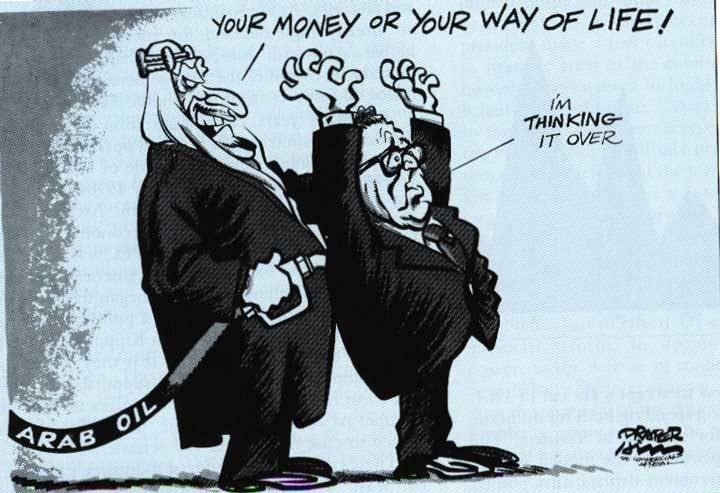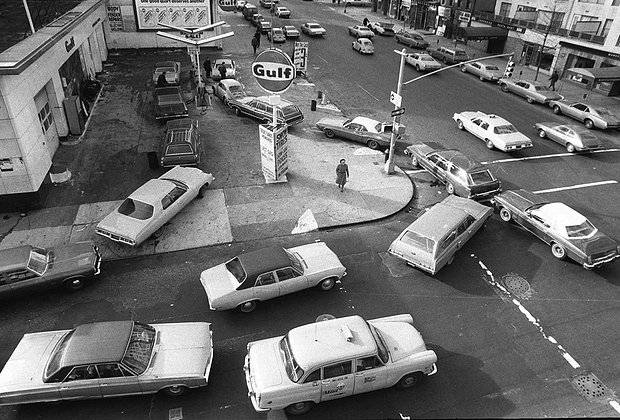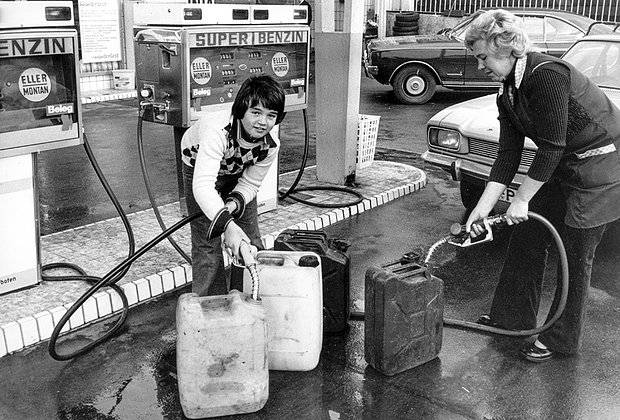How Arab sheikhs created an energy Pearl Harbor

Oil embargo
On October 6, 1973, Egypt and Syria attacked Israel. The Arab world actively supported the attack. Entire formations, units, volunteers, equipment and money came from Algeria, Morocco, Tunisia, Libya, Iraq, Jordan, Saudi Arabia, Pakistan and a number of other countries.
The conflict was also fought over economic priority. On October 17, 1973, all members of the Organization of Arab Petroleum Exporting Countries (OAPEC), as well as Egypt and Syria, imposed an embargo on supplies to states that supported Israel. The embargo was declared until “Israel completes its withdrawal from all Arab territories occupied in June 1967 and the legitimate rights of the Palestinian people are restored.”
Saudi Arabia and Kuwait immediately reduced oil production by more than 10%. On October 20–22, Arab countries, one after another, announced a cessation of oil supplies to the United States and the Netherlands, the main oil port of Western Europe.
In parallel, representatives of the Gulf oil exporting countries agreed to immediately raise the price of oil by almost 70% from $3 to $5,1 per barrel. Then, on January 1, 1974, prices increased by more than 100%. Oil was first used as weapon, and very successfully. The collective West has become accustomed to cheap fuel from the Middle East. Over the next year, the price of oil rose from US$3 to US$12 per barrel, and gasoline prices rose from 38 to 55 cents per gallon (3,7 liters).
The embargo did not last long - until March 1974, but it was enough to cause a global energy crisis. In Tokyo, Paris, Rome, Bonn (from 1949 to 1990 - the capital of Germany), London and New York, huge queues lined up for gasoline. Problems began with essential goods. The authorities began to prohibit the use of private cars for several days a week.

A line at a gas station in New York. December 1973
Energy Pearl Harbor
The United States was hit particularly hard. The states were the largest consumer of energy: 6% of the world's population used 30% of the energy produced on Earth. The country had the largest fleet of cars - 100 million. Demand for gasoline grew at an accelerated pace, along with the automobile industry. As well as fuel oil for heating systems and power plants. Therefore, almost a third of energy resources were imported, mainly from OAPEC countries.
In a special message to Congress on energy issues dated November 7, 1973, US President Richard Nixon calls on citizens to save money. They are encouraged to use cars less and conserve fuel by driving at lower speeds. Use public transport, take group trips with relatives and friends. The president called on citizens to turn down their thermostats by at least 6 degrees to bring the average temperature in homes to 68 degrees Fahrenheit (20 degrees Celsius). Turn on the lights less often; for this purpose, the schedule in schools and factories was changed.
Congress supported the president and imposed a nationwide speed limit of 55 mph. Airlines have been instructed to reduce the number of flights. Government agencies were ordered to conserve energy and reduce their vehicle fleet. The US Environmental Protection Agency is temporarily lifting restrictions on the use of polluting coal. Limits on the import of petroleum and crude oils were lifted.
On November 25, 1973, Nixon again addressed the American nation and announced new measures to combat the crisis. Among other things, he called on gas stations to stop operating on Saturday and Sunday evenings so that as few people as possible get behind the wheel over the weekend.
Under the pretext of rising costs, oil companies began to significantly increase prices for gasoline and diesel fuel, as well as aviation kerosene. Natural gas producers have demanded sharp price increases. In general, energy corporations benefited and enriched themselves from the crisis.
For American society, accustomed to cheap fuel and abundance, these problems came as a shock. After all, a car or two was a regular part of life for the average American family. Rising prices, conflicts in queues, speed limits and the constant fear of being stuck in the middle of nowhere with an empty tank were the biggest drain on truckers. At that time, private owners accounted for 70% of cargo transportation. They united and went on strike.
The largest strike occurred at the end of January - beginning of February 1974: its participants stopped all transportation and blocked major roads. Cargoes practically stopped arriving in stores, and an acute shortage of consumer goods arose in the country. The authorities even had to resort to the threat of using military force.
As a result, truckers and authorities agreed: transport companies were allowed to include a 6 percent fuel surcharge in the cost of cargo transportation and promised to provide trucks with additional fuel. Truckers showed their strength and became national heroes.
The crisis has destroyed or crippled thousands of businesses. Gas stations, roadside shops, cafes, motels, workshops, etc. were closed. The entertainment and public catering sectors suffered, consumers did not get to amusement parks and fast food restaurants. The crisis crippled the American auto industry: from 1970 to 1980, Detroit alone lost 208 thousand jobs.
Americans had to give up large and powerful cars, sell them cheap, and switch to Japanese models with four-cylinder engines that consumed less gasoline. The days of mass-produced luxury cars are over. Their sales plummeted.
The automobile concern General Motors, which was previously the most profitable industrial corporation in the United States, lost its leadership to the oil company Exxon. GM had to close 15 of 22 assembly plants and three of four body plants, and urgently redirect production to the production of small cars. Other American automakers have also been hit hard. The American auto industry was able to rebuild over time, but lost part of the market to automakers from Japan and Western Europe.
The country was plunged into such a crisis that Nixon's adviser called it "an energy Pearl Harbor." The country lost 4,7% of GDP, inflation exceeded 12%, and the stock market collapse was the largest since the Great Depression.

The family buys gasoline for future use. November 1973
US bet on Saudi Arabia
The American authorities had to rebuild their energy policy. The Ministry of Energy was created, and nuclear energy and renewable energy sources began to be developed. An oil pipeline project from Alaska was approved. In 1975, the Strategic Petroleum Reserve was created.
The economic crisis gave rise to the so-called. Big seven. In 1974, the world's leading economies established the International Energy Agency to regulate the energy market and coordinate if such crises reoccurred. In 1975, the heads of the most economically developed countries in the world - France, the USA, Great Britain, Germany, Italy and Japan - gathered near Paris to discuss the future of the world economy. This is how the “Big Six” emerged, expanding into the “Big Seven” the following year at the expense of Canada.
Oil exporters got rich. It rained money on them. Especially for the world’s largest “oil barrel” – Saudi Arabia. Washington paid closer attention to the Middle East and Arab sheikhs. The Americans and the West in general helped build modern cities in the desert with state-of-the-art infrastructure, oil refineries, oil terminals, ports, desalination and water treatment plants, power plants, pipelines, highways and airports. Advanced medical institutions, hotels, shopping and entertainment centers filled with the best goods from the USA, Japan and Germany appeared in the cities.
At the same time, the Saudis themselves did not work: they employed hundreds of thousands of workers from poorer Arab countries, Pakistan, India, etc. In just a few years, the kingdom was miraculously transformed. From poor shepherds to the developed world.
The Saudis also received security guarantees from the United States so that they would not be offended by their powerful neighbors - Syria, Iraq and Iran. At the same time, the Saudis' oil billions flowed back to the United States. They were used to buy borrowed securities of the American government and shares of American corporations. Arab sheikhs received interest and bathed in luxury. So the United States tied the Saudis to itself, the kingdom stably supplied America with “black gold”.
The United States has built a real “oil communism” for Saudi Arabia. One of the richest countries in the world, ruled by a medieval sect of religious fanatics, and at the same time the world center of Islam (the tomb of the Prophet Muhammad, the Kaaba), became the trump card of the United States. Later, already in the 1980s, the Saudis would thank the United States by starting a crusade against the USSR.
Oil weapons are used against the USSR (price collapse), the USA, Saudi Arabia and Pakistan will fight against the Union (How the US and Saudi Arabia played against us) by the hands of the Afghan Mujahideen, etc.
Information